|
| |
Back to
helicopters
|
France |
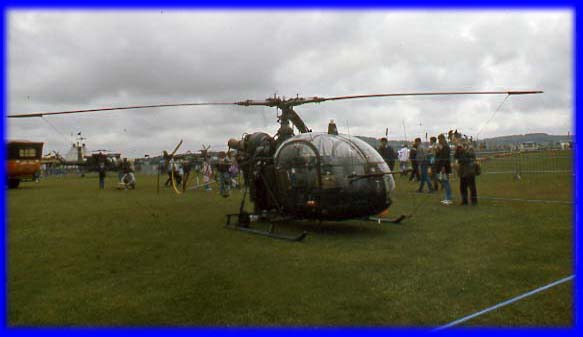 |
|
The Aerospatiale Alouette (Skylark) II, when
it first appeared in March 1955, was a world leader in being the
first production helicopter powered by a turbine engine. In a
concept similar to turboprops, the turbine's shaft was extended
forward, and drove the rotor via a gearbox and vertical shaft. The
earliest Alouettes were each powered by a 410shp (300Kw) Turbomeca
Artouste engine, but on later examples this was changed to a higher
power Astazou. Apart from the powerplant and having a three bladed
rotor, the basic configuration is similar to the American Bell 47
(Sioux), with its high visibility bubble canopy and open, skeletal
tail. The Alouette can seat up to five people, has a maximum weight
of 1,600 Kg and payload of 700 Kg. Top speed is 185 Km/H and range
if 565 Km. Over 1,500 of all versions were produced.
This one, operated by the Belgian army, was at
Middle Wallop in July 1986. |
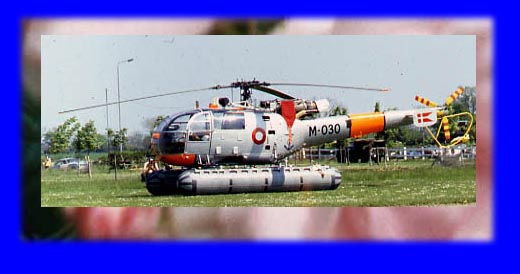 |
The Aerospatiale Alouette III was, as its
name suggests, a development of the earlier Alouette II. It is
bigger, with capacity for seven people, and heavier, with gross
weight of 2,200 Kg and payload of 1,100 Kg. Top speed is 210 Km/H
and range is 565 Km. It is powered by an uprated 425 Kw Turbomeca
Artouste engine, later superseded by a 450 Kw Astazou. Since its
first flight in February 1959, over 2,000 have been built, including
many in India known as the Hindustan Aeronautics (HAL) Chetak.
This one was operated by the Danish forces and
equipped with floats for seaborne operations. |
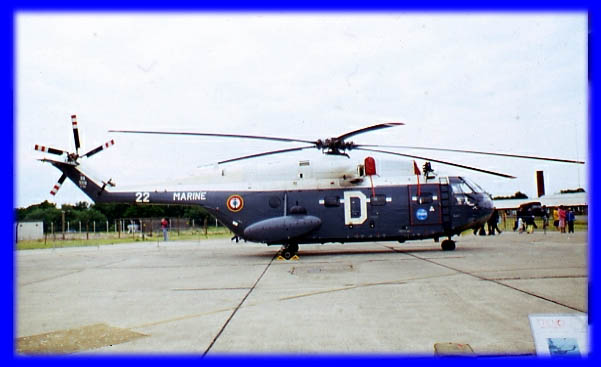 |
The Aerospatiale Super Frelon (Hornet) is a
heavy transport helicopter which is roughly contemporaneous with the
American CH-46, but the configuration foreshadows the CH-53. This is
not surprising, because Sikorsky acted as design consultant on the
project. It is powered by three 1,170 Kw Turbomeca Turmo 3C engines,
which give it a maximum gross weight of 13,000 Kg, payload of 6,100
Kg, top speed of 248 Km/H, range of 1,100 Km and capacity for five
crew plus 27 armed troops. One unusual feature is its six bladed
main rotor. Around 100 were built, almost all for the French armed
forces. This one, operated by the French
navy, was at Greenham Common in June 1981. |
|
|
The Aerospatiale Gazelle was one of the trio
of helicopters covered by the joint development agreement between
Westland and Aerospatiale, but in practice it ended up being a
predominantly French design. Of particular note is having the
multi-bladed tail rotor enclosed in a shroud, a configuration known
as a `Fenestron'. Apart from some mild efficiency benefits claimed
for this layout, the main advantage is safety: anyone unlucky enough
to walk into a rotating tail rotor would be chopped to bits, but the
Fenestron is at least shielded (though someone really determined to
have an accident could still put his arm through one). It is powered
by a single 590shp (430 Kw) Turbomeca Astazou engine. it can carry
five people, making it in effect a replacement for the Alouette 2.
Maximum weight is 1,800 Kg, and payload is 800 Kg. Top speed is a
very creditable 310 Km/h, with a range of 670 Km. It first flew in
April 1967, since when over 1,500 have been delivered to many air
forces worldwide.
The top picture shows a Gazelle AH1 of the
British Royal Marines at Yeovilton in August 1984. The lower picture
is of a Gazelle HT3 at Sandown, February 2006. |
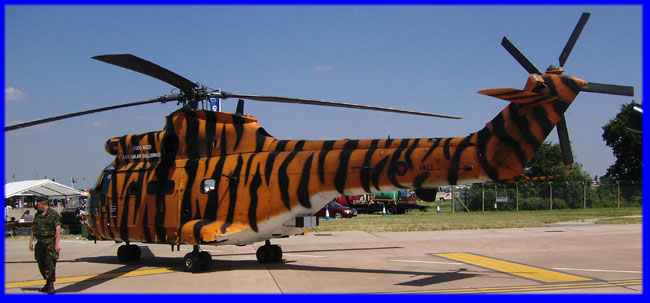 |
The Aerospatiale Puma is the other
predominantly French machine covered by the Aerospatiale / Westland
joint development agreement. A medium transport helicopter, the Puma
carries three crew and up to 16 people. Gross weight is 7,400 Kg and
payload is 3,630 Kg, making it a bit smaller than the Sikorsky Sea
King. Maximum speed is 258 Km/h, but range is limited at around 500
Km. It is powered by two 1,175shp (850 Kw) Turbomeca Turmo
turboshafts. It first flew in April 1965. About 700 were built, plus
some later Super Pumas.
This one, operated by the Royal Air Force (230
Squadron) was painted in a special colour scheme to draw attention
to the squadron's badge, a tiger. It was at Fairford in July 2005. |
|
International |
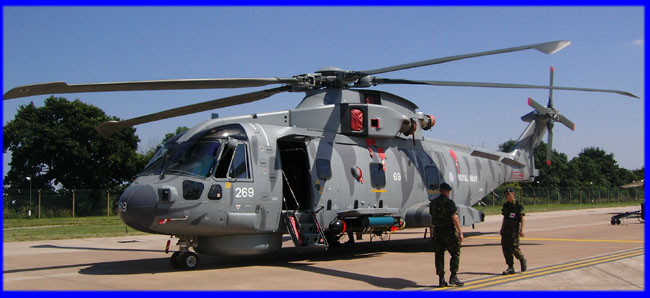 |
|
The EH101 is built by EH Industries, a
company set up by Westland of Britain and Agusta of Italy for this
sole purpose. It is a big transport helicopter; at 14,600 Kg gross
weight, it is larger than either the Super Frelon or the CH-46.
Payload is 5,500 Kg; it can carry four crew and 45 troops. It is
powered by three 2,300 shp (1,725 Kw) Rolls-Royce / Turbomeca RTM322
turboshafts. The tips of the rotors are extended into `paddles',
which reduce drag and enhance rotor performance. And here's where
the EH101 is special: although a huge transport, it is amazingly
agile, being as responsive in the air as something like a Lynx. Top
speed is 309 Km/h and range is 1,000 Km. It first flew in October
1987. Deliveries are in progress; over 100 have been delivered up to
July 2005. Pictured is a Merlin
HM1 of the Royal Navy, at Fairford in July 2005 |
|
Russia |
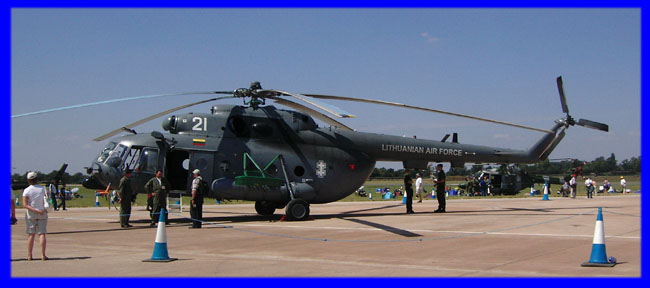 |
|
The Mil Mi8 (`Hip') was designed by Russian
helicopter specialist Mikhail L. Mil and first flew (in its classic
twin engined form) in September 1962. It is powered by two 1,500 shp
(1,085Kw) Isotov turboshafts. Maximum weight is 12,000 Kg and
payload is 4,750Kg. It can carry up to 32 people, including crew.
Top speed is 260 Km/H and range, never the strongest point of
Soviet-era machines, is 480 Km. It has a five bladed rotor. In
general, one could think of the Hip as the Russian equivalent of the
American Sea King. Well over 1,000 were built.
This one, of the Lithuanian air force, was at
Fairford in July 2005. |
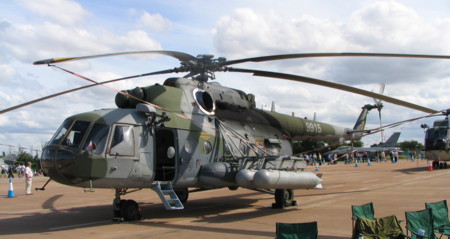 |
The Mil Mi17 shares the NATO codename `Hip'
with the Mi8, from which it was developed. It is basically nothing
more than an upgraded Mi8. Weight and payload are increased by 1,000
Kg, and range is double dto 950 Km. The Isotov turboshafts are
uprated to 1,680 Kw. Since it superseded the Mi8 in production in
about 1980, more than 800 have been produced. Like its forebear, it
has been exported worldwide. this one
was at Fairford in July 2007. |
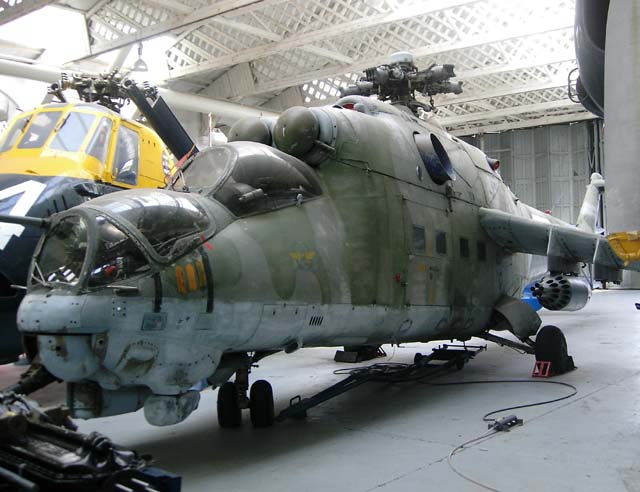
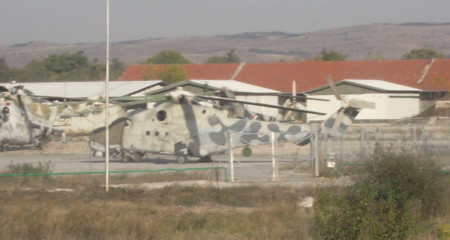 |
The Mil Mi 24 (`Hind') is known to its pilots
as the `crocodile'. It has the same engines as the Mi8, but
everything else is very different. It is very heavily armed, with a
nose-mounted machine gun, four underwing hardpoints for rockets or
other arms, and two wingtip points for anti-tank missiles. It
differs markedly from American attack helicopters in that it also
doubles as a transport, being able to take eight fully equipped
troops in addition to the two crew. Gross weight is 12,000 Kg. Top
speed is 335 Km/h and range is 450 Km. It first flew in 1969. Over
2,000 have been made.
It is said that its performance at maximum
weight in hot conditions is very marginal, so it has not been as
potent as it could have been. However true this is, it is still a
fearsome weapon.
Top: Mi24 awaiting restoration, preserved
at Duxford, England, where it was pictured in Summer 2005.
Bottom: Mi24 of the Macedonian Air Force at
Skopje, October 2007. |
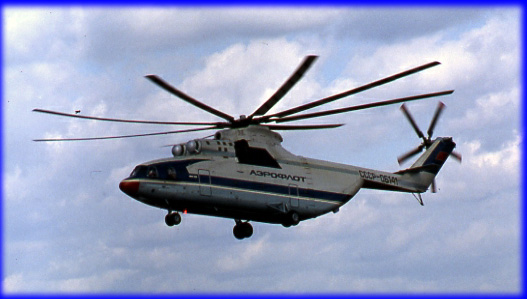 |
And if you thought the CH-53 was the ultimate
helicopter, get a load of this! It is amazing to think that even the Mil Mi26 ('Halo')
is not the world's largest helicopter (that is the Mil Mi12). But
this beast, with its massive eight bladed rotor and two 11,240 shp
(8,150 Kw) Lotarev turboshafts, has an incredible gross weight of
56,ooo Kg, and payload of 27,800 Kg (it can easily lift an empty
CH-53). It is no sluggard either: with a top speed of 295 Km/h and
range of 800 Km, this is a serious working helicopter. About 300
have been built since its first flight in December 1977.
This one was flying at Farnborough in September
1984. |





|